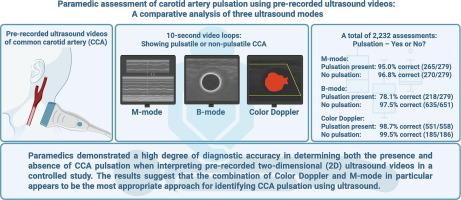Paramedic assessment of carotid artery pulsation using pre-recorded ultrasound videos: a comparative analysis of three ultrasound modes
IF 2.4
Q3 CRITICAL CARE MEDICINE
引用次数: 0
Abstract
Background
This cross-sectional study aimed to determine whether paramedics with limited or no prior ultrasound experience can consistently identify the presence or absence of common carotid artery (CCA) pulsation, as a potential alternative to manual pulse checks during cardiopulmonary resuscitation.
Methods
Following a six-minute instructional video, paramedics assessed short pre-recorded ultrasound videos of the CCA acquired in B-mode, M−mode, and Color Doppler. Each of the 93 participants viewed 24 randomized 10-second videos and classified each as showing pulsation or no pulsation. To replicate clinical conditions where manual pulse checks may fail − such as post-resuscitation − videos were recorded during two distinct phases of cardiac surgery: (1) under controlled hypotension and (2) during complete circulatory standstill following aortic clamping.
Results
A total of 2232 assessments were analyzed. M−mode: Participants correctly identified CCA pulsation in 95 % (265/279) of assessments. In videos without CCA pulsation, the correct classification of ‘no pulsation present’ was achieved in 97 % (270/279). B-mode: The presence of CCA pulsation was correctly identified in 78 % (218/279), whereas in 22 % (61/279) of cases, participants incorrectly categorized the video as ‘no pulsation present’ despite pulsation being present. Conversely, the absence of CCA pulsation was accurately detected in 98 % (635/651) of cases. Color Doppler: CCA pulsation was correctly identified in 99 % (551/558) of assessments. Similarly, in videos without CCA pulsation, participants correctly classified 96 % (185/186) as ‘no pulsation present’.
Conclusion
Paramedics demonstrated a high level of diagnostic accuracy in identifying both the presence and absence of CCA pulsation using two-dimensional (2D) ultrasound across multiple imaging modes in a controlled study setting. The findings suggest that the combination of Color Doppler and, in particular, M−mode appears to be the most suitable approach for identifying CCA pulsation via ultrasound.

护理人员评估颈动脉脉动使用预先录制的超声视频:三种超声模式的比较分析
本横断面研究旨在确定具有有限或没有超声经验的护理人员是否能够一致地识别颈总动脉(CCA)搏动的存在或不存在,作为心肺复苏期间人工脉搏检查的潜在替代方案。方法在观看6分钟的教学视频后,护理人员评估预先录制的CCA短超声视频,包括b型、M型和彩色多普勒。93名参与者每人观看了24个随机的10秒视频,并将每个视频分为有脉动和没有脉动。为了复制人工脉搏检查可能失败的临床情况(如复苏后),在心脏手术的两个不同阶段记录了视频:(1)控制低血压和(2)主动脉夹紧后完全循环停滞。结果共分析2232份评价。M−模式:参与者在95%(265/279)的评估中正确识别出CCA脉动。在没有CCA脉动的视频中,97%(270/279)实现了“无脉动存在”的正确分类。b模式:78%(218/279)的病例正确识别了CCA搏动的存在,而22%(61/279)的病例,参与者错误地将视频分类为“无搏动”,尽管搏动存在。相反,98%(635/651)的病例准确检测到CCA无搏动。彩色多普勒:99%(551/558)的评估正确识别CCA脉搏。同样,在没有CCA脉动的视频中,参与者正确地将96%(185/186)分类为“没有脉动”。结论:在一项对照研究中,医护人员使用二维(2D)超声在多种成像模式下识别CCA搏动的存在和不存在方面表现出很高的诊断准确性。研究结果表明,结合彩色多普勒,特别是M -模式似乎是最适合通过超声识别CCA脉动的方法。
本文章由计算机程序翻译,如有差异,请以英文原文为准。
求助全文
约1分钟内获得全文
求助全文
来源期刊

Resuscitation plus
Critical Care and Intensive Care Medicine, Emergency Medicine
CiteScore
3.00
自引率
0.00%
发文量
0
审稿时长
52 days
 求助内容:
求助内容: 应助结果提醒方式:
应助结果提醒方式:


